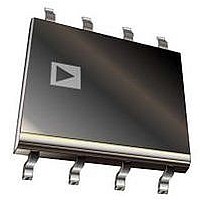IR1155STRPBF International Rectifier, IR1155STRPBF Datasheet - Page 11

IR1155STRPBF
Manufacturer Part Number
IR1155STRPBF
Description
IC PFC ONE CYCLE CONTROL 8SOIC
Manufacturer
International Rectifier
Datasheet
1.IR1155STRPBF.pdf
(21 pages)
Specifications of IR1155STRPBF
Mode
Continuous Conduction (CCM)
Frequency - Switching
Adjustable
Current - Startup
175µA
Voltage - Supply
12 V ~ 19 V
Operating Temperature
-25°C ~ 125°C
Mounting Type
*
Package / Case
*
Startup Current
175µA
Operating Supply Current
10mA
Duty Cycle (%)
99%
Frequency
200kHz
Digital Ic Case Style
SOIC
No. Of Pins
8
Operating Temperature Range
-25°C To +125°C
Peak Reflow Compatible (260 C)
Yes
Rohs Compliant
Yes
Leaded Process Compatible
Yes
Package
8-lead SOIC
Circuit
PFC IC
Vcc Range (v)
12V-20V
Out Peak Current (a)
+/- 1.5
Switching Frequency (khz)
48 - 200
Environment
Industrial
Over-voltage Protection
Yes
Brown-out Protection
Yes
Pbf
Yes
Lead Free Status / RoHS Status
Lead free / RoHS Compliant
Other names
IR1155STRPBFTR
Available stocks
Company
Part Number
Manufacturer
Quantity
Price
Part Number:
IR1155STRPBF
Manufacturer:
IR
Quantity:
20 000
www.irf.com
IR1155 General Description
The μPFC IR1155 IC is intended for power factor
correction in continuous conduction mode Boost
PFC converters operating at fixed switching
frequency with average current mode control.
The switching frequency is programmable any
where from 48kHz to 200khz. The IC operates
according to IR's proprietary "One Cycle Control"
(OCC) PFC algorithm, which is based on the re-
settable integrator principle. When operating a
AC-DC Boost converter, power factor correction
can be achieved using this algorithm without AC
input line sensing.
Theory of Operation
The OCC algorithm works using two loops - a
slow outer voltage loop and a fast inner current
loop. The outer voltage loop monitors the VFB
pin to maintain regulation of boost converter
output voltage and generates a constant error
signal. The inner current loop exploits the
embedded input voltage information in the boost
converter duty cycle to generate a current
reference for power factor correction.
combination of the two control elements forces
the amplitude and shape of the input current to
be proportional to and in phase with the input
voltage
regulation. This is true so long as operation in
continuous conduction mode is maintained.
Average current mode operation is envisaged by
filtering the switching frequency ripple from the
current sense signal in the current loop using an
on-chip filter.
The
instantaneous duty cycle using the voltage
feedback loop error signal V
sense signal V
current sense pin of the IC. The PWM ramp is
generated using a resettable integrator that
tracks V
sense signal is amplified by the current amplifier
averaged to remove the ripple component and
fed into the summing node where it is subtracted
from the voltage error signal, V
voltage (V
PWM ramp signal by the PWM comparator to
determine the gate drive duty cycle. The
instantaneous duty cycle is mathematically given
by:
D = (V
A more detailed description of IR1155 theory of
operation is available in Application Note.
m
IC
- g
m
while
m
DC
determines
every switching cycle. The current
.V
- g
ISNS
ISNS
DC
maintaining
) /V
.V
, which is the voltage at the
ISNS
m
) is compared with the
the
m
boost
output
and the current
m
. The resulting
converter
voltage
The
11
Feature set
The IR1155 offers a host of advanced features and
system protections functions, which makes it the
most feature-intensive IC in PFC market in a
compact 8-pin package.
User-Programmable Switching Frequency
IR1155
frequency.
programmed by inserting a capacitor between
FREQ & COM pins. A pair of current sources inside
the IC source/sink current in/out of the capacitor
alternately thus generating a constant-slope saw-
tooth ramp signal between a pre-determined peak &
valley voltage pair (typically between 2V to 4V). This
saw-tooth signal is the oscillator signal of the IC.
The frequency of operation of the IC can be
programmed anywhere between 48kHz and 200kHz
by suitably sizing the capacitor. The oscillator signal
is a key control signal and is used by the resettable
integrator block of the IC to generate the internal
PWM ramp every switching cycle.
IC Supply Circuit & Low start-up current
The IR1155 UVLO circuit maintains the IC in UVLO
mode during start-up if VCC pin voltage is less than
the VCC turn-on threshold, V
consumption is less than I
voltage should drop below UVLO threshold V
anytime after start-up, the IC is pushed back into
UVLO mode (VCOMP pin is discharged) and VCC
pin has to exceed V
It is noted that there is no internal clamping of the
VCC pin.
User initiated Micropower Sleep mode
The IC can be actively pushed into a micropower
sleep mode where current consumption is less than
I
threshold, V
V
application stand-by situations in order to meet
regulations (Blue Angel, Green Power etc). When
OVP/EN pin is pulled low, the VCOMP pin of the IC
is actively discharged as the IC is relegated to the
Sleep mode. This enables the IC to go through soft-
start when the IC is re-enabled. Since V
less than 1V, even logic level signals can be
employed to disable and enable the IC.
CC,SLEEP
CC,ON
. This allows the user to disable PFC during
by pulling OVP/EN pin below the Sleep
IC
The
SLEEP(OFF)
operates
switching
CC,ON
, even while VCC is above
again to re-start operation.
under
CC,START
© 2011 International Rectifier
frequency
CC,ON
. Should VCC pin
IR1155S
fixed
and current
SLEEP(OFF)
switching
is
CC, UVLO
user-
is












